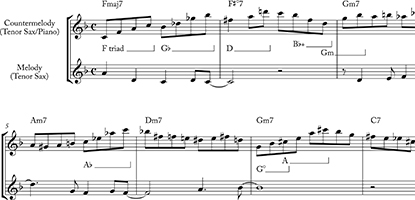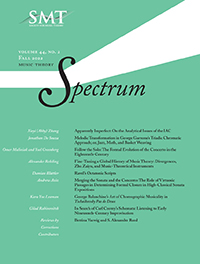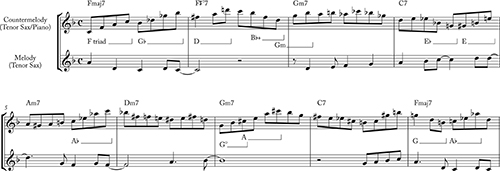Jonathan De Souza’s Music Theory Spectrum article among “Most Read of 2022”

Prof. Jonathan De Souza’s latest article is one of Oxford University Press’s “Most Read in Music” for 2022. The article was published in the Fall 2022 issue of Music Theory Spectrum. In it, De Souza examines a technique for improvising melodies created by the jazz saxophonist and educator George Garzone.

These melodies outline triads, using arpeggios instead of scales. Yet Garzone’s “Triadic Chromatic Approach” adds two simple rules. First, consecutive triads must be connected by a semitone. Second, a particular inversion—a particular triadic arrangement—cannot be repeated twice in a row. These simple rules produce complex melodies. The melodies do not belong to a major or minor key, but they mysteriously resolve to any underlying harmony.
De Souza uses music theory and mathematics to study the Triadic Chromatic Approach. He maps all of the melodic shapes that are possible in the method. And he shows that Garzone’s rules create a mathematical process called a “random walk”, whose properties make the melodies resolve. However, De Souza also emphasizes that analyzing the approach is different from performing it. Here, he considers statements from Garzone and his students, as well as ideas from anthropology and philosophy. Above all, the Triadic Chromatic Approach is meant to be practiced. It disrupts musical habits and opens up new ways of improvising.
De Souza’s research combines music theory, cognitive science, and philosophy. He is an Associate Professor of Music Theory and Director of Western’s Graduate Collaborative Specialization in Music Cognition. De Souza first presented his work on the Triadic Chromatic Approach at a Don Wright Faculty of Music Graduate Colloquium and the Society for Music Theory’s Annual Conference in 2014.
Read full article
"Melodic Transformation in George Garzone’s Triadic Chromatic Approach; or, Jazz, Math, and Basket Weaving" (via Oxford University Press)
Top image (cropped above, in full below): via Oxford University Press website - "Example One: George Garzone, arrangement of “Have You Met Miss Jones?” from Four’s and Two’s (1996), mm. 1–9 (Garzone 2009, 59). My annotations highlight triads embedded in the countermelody."


